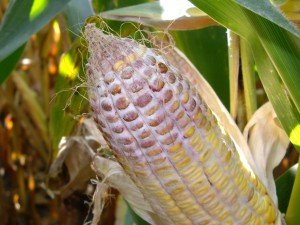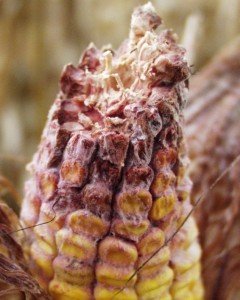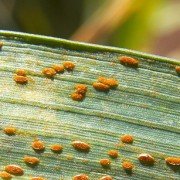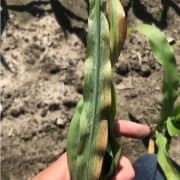Gibberella Ear Rot in corn
What is it?
Gibberella Ear Rot, or Red Ear Rot, is caused by the fungus, Gibberella zeae (Fusarium graminearum). This disease can occur throughout the U.S. Mid-West and Southern Ontario. The pathogen overwinters on corn, wheat and barley debris. Spores produced on the debris lead to infection during silking. Red Ear Rot is more prevalent when cool, wet weather occurs during the first 21 days after silking. Extended periods of rain in the fall, which delay dry down, increase the severity of the disease. Red Ear Rot will be most severe in fields where corn follows corn, or corn follows wheat that was affected by Fusarium head blight (scab), which is caused by the same pathogen.
Symptoms
- Reddish mold appears first at the ear tip and spreads downward
- The ear most often be only partially covered with the reddish mycelium
- Early infection may cause the entire ear to be colonized with mycelium and partially rotted, which may cause the ear to be glued to the husk
- Tiny black fruiting structures may be found on the husks and ear shanks
Pathogen involved
- Gibberella zeae (Fusarium graminearum) (a fungus)
- This pathogen produces multiple mycotoxins that are harmful to humans as well as animals
- Overwinters in corn residue
- The same pathogen causes head scab (blight) of wheat and barley
Time of occurrence
- Infection takes place within the silks or at the base of the ear when heavy rainfall occurs late in the season
- This disease occurs after silking
Conditions favouring disease
- Cool and wet conditions soon after silking
- Corn on corn rotation, or a wheat and corn rotation
- Wheat or corn residue on soil surface
- Damaged kernels
Disease management
- Corn hybrids differ in susceptibility, but resistant hybrids not reported
- Corn hybrid with tight husks may be more susceptible
- Crop rotation
- Fall tillage may be helpful where appropriate
Danger to livestock
The pathogen that causes Gibberella Ear Rot can produce two mycotoxins in the infected kernels: deoxynivalenol and zearalenone. These mycotoxins can affect the health of many monogastric animals, but swine are especially sensitive. If Gibberella ear rot is present, assume that the mycotoxins are also present. A test is needed to determine the level of contamination.
- Deoxynivalenol: Deoxynivalenol, also known as DON and vomitoxin, causes swine and other animals to refuse infected grain and regurgitate feed.
- Zearalenone: Zearalenone has estrogenic properties, which means it can cause infertility, abortion, or other breeding problems. As little as 1 to 5 ppm zearalenone in a feed ration may produce an estrogenic effect in swine.
Minimizing economic loss
Producers with Gibberella Ear Rot in their fields often ask when they should harvest. We base our advice on the fact that grain moisture and temperature influence fungal growth. When grain moisture is more than 22% and the temperature is near 27°C, fungal growth and mycotoxin production will continue in the ear. Cooler temperatures will slow growth; however, periods of cold weather (below 10°C) can increase production of the mycotoxin zearalenone, especially if the temperature turns warm again. Disease spread and mycotoxin development should cease when grain moisture content falls below 18%.
Thus, fields with significant amounts of Gibberella Ear Rot should be harvested as early as possible and handled separately. Mycotoxin concentrations are almost always higher in fines and screenings, and combines should be adjusted to reduce the amount of fines and small, shriveled, or broken kernels. Immediately after harvest grain should be dried to 15% moisture. Properly storing grain at or below 15% moisture will prevent further fungal growth and mycotoxin production.
Managing the disease
To prevent future Gibberella Ear Rot outbreaks, tillage following a corn rotation is encouraged. Rotation out of corn (or wheat) will allow infected residue to de-grade, reducing the presence of the fungus that causes the disease. Corn hybrids vary in their resistance to Gibberella Ear Rot.
Sources: Jorge Acevedo, Corn Agronomist, Dow Seeds; University of Illinois, College of Agricultural, Consumer and Environmental Sciences; University of Guelph, Ridgetown College, Purdue University; Purdue Extension.











